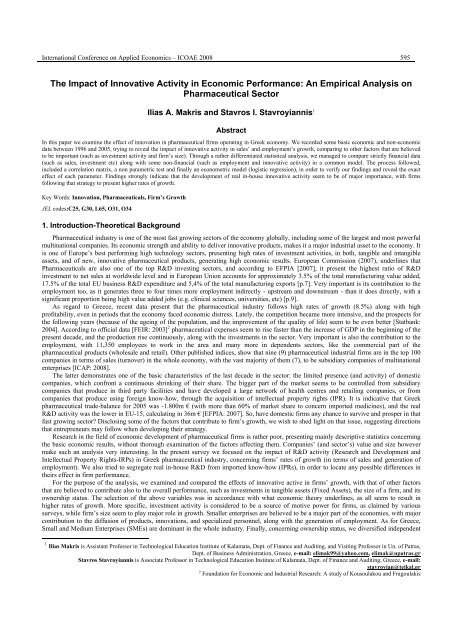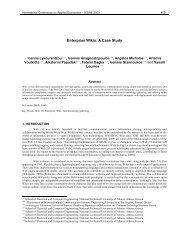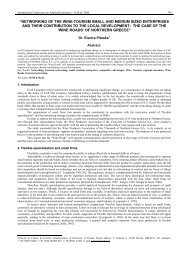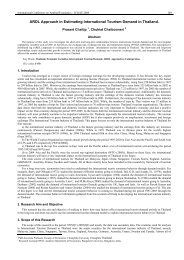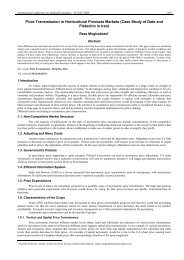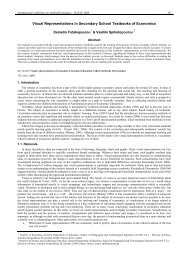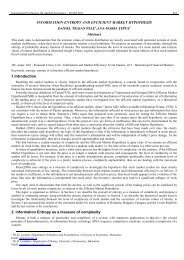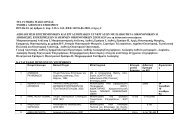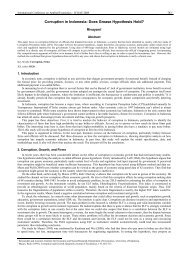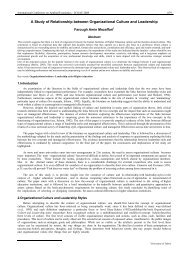The Impact of Innovative Activity in Economic Performance: An ...
The Impact of Innovative Activity in Economic Performance: An ...
The Impact of Innovative Activity in Economic Performance: An ...
Create successful ePaper yourself
Turn your PDF publications into a flip-book with our unique Google optimized e-Paper software.
International Conference on Applied <strong>Economic</strong>s – ICOAE 2008 595<br />
<strong>The</strong> <strong>Impact</strong> <strong>of</strong> <strong>Innovative</strong> <strong>Activity</strong> <strong>in</strong> <strong>Economic</strong> <strong>Performance</strong>: <strong>An</strong> Empirical <strong>An</strong>alysis on<br />
Pharmaceutical Sector<br />
Ilias A. Makris and Stavros I. Stavroyiannis 1<br />
Abstract<br />
In this paper we exam<strong>in</strong>e the effect <strong>of</strong> <strong>in</strong>novation <strong>in</strong> pharmaceutical firms operat<strong>in</strong>g <strong>in</strong> Greek economy. We recorded some basic economic and non-economic<br />
data between 1996 and 2005, try<strong>in</strong>g to reveal the impact <strong>of</strong> <strong>in</strong>novative activity <strong>in</strong> sales’ and employment’s growth, compar<strong>in</strong>g to other factors that are believed<br />
to be important (such as <strong>in</strong>vestment activity and firm’s size). Through a rather differentiated statistical analysis, we managed to compare strictly f<strong>in</strong>ancial data<br />
(such as sales, <strong>in</strong>vestment etc) along with some non-f<strong>in</strong>ancial (such as employment and <strong>in</strong>novative activity) <strong>in</strong> a common model. <strong>The</strong> process followed,<br />
<strong>in</strong>cluded a correlation matrix, a non parametric test and f<strong>in</strong>ally an econometric model (logistic regression), <strong>in</strong> order to verify our f<strong>in</strong>d<strong>in</strong>gs and reveal the exact<br />
effect <strong>of</strong> each parameter. F<strong>in</strong>d<strong>in</strong>gs strongly <strong>in</strong>dicate that the development <strong>of</strong> real <strong>in</strong>-house <strong>in</strong>novative activity seem to be <strong>of</strong> major importance, with firms<br />
follow<strong>in</strong>g that strategy to present higher rates <strong>of</strong> growth.<br />
Key Words: Innovation, Pharmaceuticals, Firm’s Growth<br />
JEL codes:C25, G30, L65, O31, O34<br />
1. Introduction-<strong>The</strong>oretical Background<br />
Pharmaceutical <strong>in</strong>dustry is one <strong>of</strong> the most fast grow<strong>in</strong>g sectors <strong>of</strong> the economy globally, <strong>in</strong>clud<strong>in</strong>g some <strong>of</strong> the largest and most powerful<br />
mult<strong>in</strong>ational companies. Its economic strength and ability to deliver <strong>in</strong>novative products, makes it a major <strong>in</strong>dustrial asset to the economy. It<br />
is one <strong>of</strong> Europe’s best perform<strong>in</strong>g high technology sectors, present<strong>in</strong>g high rates <strong>of</strong> <strong>in</strong>vestment activities, <strong>in</strong> both, tangible and <strong>in</strong>tangible<br />
assets, and <strong>of</strong> new, <strong>in</strong>novative pharmaceutical products, generat<strong>in</strong>g high economic results. European Commission (2007), underl<strong>in</strong>es that<br />
Pharmaceuticals are also one <strong>of</strong> the top R&D <strong>in</strong>vest<strong>in</strong>g sectors, and accord<strong>in</strong>g to EFPIA [2007], it present the highest ratio <strong>of</strong> R&D<br />
<strong>in</strong>vestment to net sales at worldwide level and <strong>in</strong> European Union accounts for approximately 3.5% <strong>of</strong> the total manufactur<strong>in</strong>g value added,<br />
17.5% <strong>of</strong> the total EU bus<strong>in</strong>ess R&D expenditure and 5,4% <strong>of</strong> the total manufactur<strong>in</strong>g exports [p.7]. Very important is its contribution to the<br />
employment too, as it generates three to four times more employment <strong>in</strong>directly - upstream and downstream - than it does directly, with a<br />
significant proportion be<strong>in</strong>g high value added jobs (e.g. cl<strong>in</strong>ical sciences, universities, etc) [p.9].<br />
As regard to Greece, recent data present that the pharmaceutical <strong>in</strong>dustry follows high rates <strong>of</strong> growth (8.5%) along with high<br />
pr<strong>of</strong>itability, even <strong>in</strong> periods that the economy faced economic distress. Lately, the competition became more <strong>in</strong>tensive, and the prospects for<br />
the follow<strong>in</strong>g years (because <strong>of</strong> the age<strong>in</strong>g <strong>of</strong> the population, and the improvement <strong>of</strong> the quality <strong>of</strong> life) seem to be even better [Statbank:<br />
2004]. Accord<strong>in</strong>g to <strong>of</strong>ficial data [FEIR: 2003] 2 pharmaceutical expenses seem to rise faster than the <strong>in</strong>crease <strong>of</strong> GDP <strong>in</strong> the beg<strong>in</strong>n<strong>in</strong>g <strong>of</strong> the<br />
present decade, and the production rise cont<strong>in</strong>uously, along with the <strong>in</strong>vestments <strong>in</strong> the sector. Very important is also the contribution to the<br />
employment, with 11,350 employees to work <strong>in</strong> the area and many more <strong>in</strong> dependents sectors, like the commercial part <strong>of</strong> the<br />
pharmaceutical products (wholesale and retail). Other published <strong>in</strong>dices, show that n<strong>in</strong>e (9) pharmaceutical <strong>in</strong>dustrial firms are <strong>in</strong> the top 100<br />
companies <strong>in</strong> terms <strong>of</strong> sales (turnover) <strong>in</strong> the whole economy, with the vast majority <strong>of</strong> them (7), to be subsidiary companies <strong>of</strong> mult<strong>in</strong>ational<br />
enterprises [ICAP: 2008].<br />
<strong>The</strong> latter demonstrates one <strong>of</strong> the basic characteristics <strong>of</strong> the last decade <strong>in</strong> the sector: the limited presence (and activity) <strong>of</strong> domestic<br />
companies, which confront a cont<strong>in</strong>uous shr<strong>in</strong>k<strong>in</strong>g <strong>of</strong> their share. <strong>The</strong> bigger part <strong>of</strong> the market seems to be controlled from subsidiary<br />
companies that produce <strong>in</strong> third party facilities and have developed a large network <strong>of</strong> health centres and retail<strong>in</strong>g companies, or from<br />
companies that produce us<strong>in</strong>g foreign know-how, through the acquisition <strong>of</strong> <strong>in</strong>tellectual property rights (IPR). It is <strong>in</strong>dicative that Greek<br />
pharmaceutical trade-balance for 2005 was -1.800m € (with more than 60% <strong>of</strong> market share to concern imported medic<strong>in</strong>es), and the real<br />
R&D activity was the lower <strong>in</strong> EU-15, calculat<strong>in</strong>g <strong>in</strong> 36m € [EFPIA: 2007]. So, have domestic firms any chance to survive and prosper <strong>in</strong> that<br />
fast grow<strong>in</strong>g sector? Disclos<strong>in</strong>g some <strong>of</strong> the factors that contribute to firm’s growth, we wish to shed light on that issue, suggest<strong>in</strong>g directions<br />
that entrepreneurs may follow when develop<strong>in</strong>g their strategy.<br />
Research <strong>in</strong> the field <strong>of</strong> economic development <strong>of</strong> pharmaceutical firms is rather poor, present<strong>in</strong>g ma<strong>in</strong>ly descriptive statistics concern<strong>in</strong>g<br />
the basic economic results, without thorough exam<strong>in</strong>ation <strong>of</strong> the factors affect<strong>in</strong>g them. Companies’ (and sector’s) value and size however<br />
make such an analysis very <strong>in</strong>terest<strong>in</strong>g. In the present survey we focused on the impact <strong>of</strong> R&D activity (Research and Development and<br />
Intellectual Property Rights-IRPs) <strong>in</strong> Greek pharmaceutical <strong>in</strong>dustry, concern<strong>in</strong>g firms’ rates <strong>of</strong> growth (<strong>in</strong> terms <strong>of</strong> sales and generation <strong>of</strong><br />
employment). We also tried to segregate real <strong>in</strong>-house R&D from imported know-how (IPRs), <strong>in</strong> order to locate any possible differences <strong>in</strong><br />
theirs effect <strong>in</strong> firm performance.<br />
For the purpose <strong>of</strong> the analysis, we exam<strong>in</strong>ed and compared the effects <strong>of</strong> <strong>in</strong>novative active <strong>in</strong> firms’ growth, with that <strong>of</strong> other factors<br />
that are believed to contribute also to the overall performance, such as <strong>in</strong>vestments <strong>in</strong> tangible assets (Fixed Assets), the size <strong>of</strong> a firm, and its<br />
ownership status. <strong>The</strong> selection <strong>of</strong> the above variables was <strong>in</strong> accordance with what economic theory underl<strong>in</strong>es, as all seem to result <strong>in</strong><br />
higher rates <strong>of</strong> growth. More specific, <strong>in</strong>vestment activity is considered to be a source <strong>of</strong> motive power for firms, as claimed by various<br />
surveys, while firm’s size seem to play major role <strong>in</strong> growth. Smaller enterprises are believed to be a major part <strong>of</strong> the economies, with major<br />
contribution to the diffusion <strong>of</strong> products, <strong>in</strong>novations, and specialized personnel, along with the generation <strong>of</strong> employment. As for Greece,<br />
Small and Medium Enterprises (SMEs) are dom<strong>in</strong>ant <strong>in</strong> the whole <strong>in</strong>dustry. F<strong>in</strong>ally, concern<strong>in</strong>g ownership status, we diversified <strong>in</strong>dependent<br />
1 Ilias Makris is Assistant Pr<strong>of</strong>essor <strong>in</strong> Technological Education Institute <strong>of</strong> Kalamata, Dept. <strong>of</strong> F<strong>in</strong>ance and Audit<strong>in</strong>g, and Visit<strong>in</strong>g Pr<strong>of</strong>essor <strong>in</strong> Un. <strong>of</strong> Patras,<br />
Dept. <strong>of</strong> Bus<strong>in</strong>ess Adm<strong>in</strong>istration, Greece, e-mail: elimak99@yahoo.com, elimak@upatras.gr<br />
Stavros Stavroyiannis is Associate Pr<strong>of</strong>essor <strong>in</strong> Technological Education Institute <strong>of</strong> Kalamata, Dept. <strong>of</strong> F<strong>in</strong>ance and Audit<strong>in</strong>g, Greece, e-mail:<br />
stavroyian@teikal.gr<br />
2 Foundation for <strong>Economic</strong> and Industrial Research: A study <strong>of</strong> Kousoulakou and Fragoulakis
596 International Conference on Applied <strong>Economic</strong>s – ICOAE 2008<br />
firms from subsidiary companies, <strong>in</strong> order to reveal any possible differences <strong>in</strong> economic performance (as the latter are believed to have more<br />
chances to grow, be<strong>in</strong>g supported from the parent company).<br />
2. Research and Development<br />
Research and Development (and <strong>in</strong>novative activity <strong>in</strong> general), is considered to be a crucial factor for technological and economic<br />
development and focused policies are established <strong>in</strong> order to encourage and support firms to develop such activities (especially Small and<br />
Medium Enterprises), as they seem to contribute not only to economic welfare (<strong>in</strong> terms <strong>of</strong> turnover, pr<strong>of</strong>itability, etc.), but also to noneconomic<br />
too (generation <strong>of</strong> employment, establishment <strong>of</strong> new technologies etc.), and generally, to high and fast rates <strong>of</strong> growth 3 . To a<br />
recent paper, Kafouros [2005], found that R&D process is correlated positively with productivity growth and sales, especially <strong>in</strong> high-tech<br />
sectors [p.492], such as tend to be pharmaceuticals as already mentioned, while Delapierre et al [1998], claimed that it results <strong>in</strong> <strong>in</strong>crease <strong>of</strong><br />
the level <strong>of</strong> sectoral and national economic performance, diffus<strong>in</strong>g <strong>in</strong>novative products [p.990]. <strong>The</strong> contribution <strong>of</strong> <strong>in</strong>novative firms (ma<strong>in</strong>ly<br />
SMEs) to the overall economic growth has been underl<strong>in</strong>ed also from Ferguson and Ol<strong>of</strong>sson [2004, p.5], while a survey <strong>of</strong> Autio and<br />
Parhankangas [1998], concluded that <strong>in</strong>novative firms, even dur<strong>in</strong>g economic recessions, seem to <strong>in</strong>crease their employment and sales<br />
generation [p.120]. Surveys for Greece [Tselekidis, et al 2003 and Makris 2007], also found that firms perform<strong>in</strong>g <strong>in</strong>novative activities, enjoy<br />
the last decade higher rate <strong>of</strong> growth <strong>in</strong> turnover and employment, than their sector’s average.<br />
As regard to pharmaceutical sector, literature (although limited), concluded to similar results. Indicatively, Jefferson et al (2006), <strong>in</strong> a<br />
survey concern<strong>in</strong>g Ch<strong>in</strong>a, claimed that one <strong>of</strong> the sectors that present the highest <strong>in</strong>cidence <strong>of</strong> R&D performers is pharmaceutical <strong>in</strong>dustry,<br />
enjoy<strong>in</strong>g significant returns (from <strong>in</strong>creased sales). Also, Penner-Hahn and Shaver (2005), <strong>in</strong> their study for Japan, showed that <strong>in</strong>ternational<br />
R&D activities (enhanced with exist<strong>in</strong>g research capabilities) <strong>in</strong>crease the performance and the expansion <strong>of</strong> the pharmaceutical firms.<br />
3. Statistical <strong>An</strong>alysis<br />
In order to create our sample, we used micro-level data from the database <strong>of</strong> ICAP’s Greek F<strong>in</strong>ancial Directory 4 , for the last decade<br />
(1996-2005). We first located all manufactur<strong>in</strong>g firms activat<strong>in</strong>g <strong>in</strong> Greek economy that produce pharmaceutical products, us<strong>in</strong>g the NACE<br />
<strong>in</strong>dustry classification (Classification <strong>of</strong> <strong>Economic</strong> Activities <strong>in</strong> the European Community), and choos<strong>in</strong>g the firms that have the code 2442<br />
(that is: ma<strong>in</strong> activity, production <strong>of</strong> pharmaceutical products). We f<strong>in</strong>ally collected data from 74 firms. We then excluded all firms that were<br />
established after 1990, because we wanted to avoid possible bias <strong>in</strong> data set, as most firms <strong>in</strong> the first years <strong>of</strong> their operation present usually,<br />
higher rates <strong>of</strong> expenditure <strong>in</strong> order to create the necessary <strong>in</strong>frastructure, with very poor however, economic results. Through the above<br />
process, 51 firms were f<strong>in</strong>ally located and the next step was to collect economic data from their balance-sheets for the period exam<strong>in</strong>ed,<br />
concern<strong>in</strong>g <strong>in</strong>vestment <strong>in</strong> tangible assets (Fixed Assets), Research and Development (expenses for Research and Development and<br />
Intellectual Property Rights 5 ) and turnover (sales). Furthermore, we diversified our sample to completely Greek-owned firms and to<br />
subsidiaries, <strong>in</strong> order to exam<strong>in</strong>e the overall effect <strong>of</strong> ownership status <strong>in</strong> firm’s performance, as many companies (with high market share)<br />
produce ma<strong>in</strong>ly <strong>in</strong> third parties facilities import<strong>in</strong>g and us<strong>in</strong>g foreign Know-how and do not perform any <strong>in</strong>-house R&D activity. F<strong>in</strong>ally, a<br />
segregation <strong>of</strong> the firms was followed, accord<strong>in</strong>g to their size (number <strong>of</strong> personnel), as SMEs are considered to achieve higher rates <strong>of</strong><br />
growth.<br />
<strong>The</strong> next step was to make our data compatible for statistical analysis. Thus, we calculated the change <strong>in</strong> turnover through the period<br />
exam<strong>in</strong>ed, along with sample’s average rate <strong>of</strong> change, follow<strong>in</strong>g the same process as regard to the non-economic factor (Employment). <strong>The</strong>n,<br />
we gave the value one (1) to the firms that exceed the average rate <strong>of</strong> turnover’s growth (<strong>of</strong> the sample), and zero (0) to those that are below<br />
the average. We followed the same process for employment, creat<strong>in</strong>g f<strong>in</strong>ally two discrete dichotomous variables that we used as dependents<br />
<strong>in</strong> our analysis.<br />
We then discrim<strong>in</strong>ate <strong>in</strong>novative from non-<strong>in</strong>novative firms, giv<strong>in</strong>g the value two (2) to the firms that present expenses concern<strong>in</strong>g R&D<br />
and IPRs, and one (1) to those that do not perform such activities, creat<strong>in</strong>g another discrete variable that we used later as explanatory factor.<br />
As already underl<strong>in</strong>ed, such activities disclose the existence <strong>of</strong> any type <strong>of</strong> <strong>in</strong>novative process <strong>in</strong> the firm. Our next variable (<strong>of</strong> the same<br />
form) was developed from the rate <strong>of</strong> <strong>in</strong>vestment <strong>in</strong> fixed assets <strong>in</strong> the period exam<strong>in</strong>ed, by calculat<strong>in</strong>g the rate <strong>of</strong> growth <strong>in</strong> <strong>in</strong>vestment <strong>in</strong><br />
fixed assets from 1996 to 2005 for each firm, and subtract<strong>in</strong>g that (for each one) from the average sectoral’s growth. Through the above<br />
process, we created a cont<strong>in</strong>uous variable tak<strong>in</strong>g any value (positive or negative). With that variable we wanted to test the hypothesis that the<br />
<strong>in</strong>tense <strong>of</strong> the <strong>in</strong>vestment activities <strong>in</strong> fixed assets, is related (positively) to higher growth <strong>of</strong> sales. F<strong>in</strong>ally, two more variables were<br />
developed, diversify<strong>in</strong>g the firms as regard to:<br />
i) their size:<br />
• 1-50 employees (very small firms) tak<strong>in</strong>g the value (1)<br />
• 51-100 employees (small firms) tak<strong>in</strong>g the value (2)<br />
• 101-250 (medium firms) employees tak<strong>in</strong>g the value (3)<br />
• more than 250 employees (large firms) tak<strong>in</strong>g the value (4)<br />
ii) their’s ownership status: to those that are completely Greek-owned (tak<strong>in</strong>g the value 2) and those that are subsidiaries <strong>of</strong><br />
mult<strong>in</strong>ational corporations (tak<strong>in</strong>g the value 1). Our scope is to test whether the growth <strong>of</strong> a company is depended on its status (implicat<strong>in</strong>g<br />
that maybe the subsidiary companies are <strong>in</strong> a better competitive position).<br />
All the variables described, are apposed below (along with their <strong>in</strong>terpretation and codification):<br />
• Dependent variables (discrete):<br />
3 See <strong>in</strong>dicatively f<strong>in</strong>d<strong>in</strong>gs <strong>of</strong> various surveys, supported that theory: Reed and Moreno: 1986, Storey and Tether: 1998, LIFT: 1998, Giudici and Paleari: 2000,<br />
Bartjokas: 2001.<br />
4 A Greek private company, considered as the most <strong>in</strong>clusive database conta<strong>in</strong><strong>in</strong>g f<strong>in</strong>ancial <strong>in</strong>formation <strong>of</strong> firms <strong>of</strong> all sectors. <strong>The</strong> reader may f<strong>in</strong>d more<br />
details, <strong>in</strong> www.icap.gr<br />
5 In that account, are <strong>in</strong>cluded all the <strong>in</strong>tangible assets that are acquired from the firm, either through buy<strong>in</strong>g <strong>in</strong> or by produc<strong>in</strong>g them, with the prospect, to<br />
enjoy monopolistic advantage (through patents-Royalties etc.), and as a result, higher economic performance than its competitors.
International Conference on Applied <strong>Economic</strong>s – ICOAE 2008 597<br />
o Turnover’s growth (DS96_05: change <strong>in</strong> sales, higher or lower than sample’s average)<br />
o Employment’s growth (DE96_05: change <strong>in</strong> employment, higher or lower than sample’s average)<br />
• Independent variable<br />
o <strong>Innovative</strong> activities (Innovation=RandD and IPRs)<br />
o Fixed assets’ change (DF96_05: difference/variance from the average sample’s change - cont<strong>in</strong>uous)<br />
o <strong>The</strong> size <strong>of</strong> the firm (Size: number <strong>of</strong> personnel)<br />
o <strong>The</strong> ownership status (Ownership: whether the firm is completely Greek-owned or is a subsidiary company <strong>of</strong> a large<br />
mult<strong>in</strong>ational company - discrete)<br />
4. Empirical Results<br />
4.1. Correlation and Non-Parametric Test<br />
Our overall scope was to test whether such activation generates higher rates <strong>of</strong> growth for the firms (<strong>in</strong> terms <strong>of</strong> sales and employment),<br />
as generally considered. For that purpose, we firstly tried to locate some possible correlations between the sales’ growth and the established<br />
variables 6 .<br />
Table 1: Correlation matrix<br />
Ownershi<br />
DS96_05 Innovation DE96_05 DF96_05 p Size<br />
DS96_05 Pearson<br />
Correlation<br />
1 ,349(*) ,402(**) ,276(*) ,100 ,090<br />
Sig. (2-tailed) ,012 ,003 ,050 ,487 ,530<br />
Sum <strong>of</strong> Squares<br />
and Crossproducts<br />
12,627 3,863 4,980<br />
7966,77<br />
1<br />
1,039 2,725<br />
Covariance ,253 ,077 ,100 159,335 ,021 ,055<br />
DE96_05 Pearson<br />
Correlation<br />
,402(**) ,378(**) 1 -,048 ,067 ,309(*)<br />
Sig. (2-tailed)<br />
Sum <strong>of</strong> Squares<br />
,003 ,006 ,740 ,640 ,027<br />
and<br />
productsCross-<br />
4,980 4,098 12,157 -1349,348 ,686 9,196<br />
Covariance ,100 ,082 ,243 -26,987 ,014 ,184<br />
* Correlation is significant at the 0.05 level (2-tailed).<br />
** Correlation is significant at the 0.01 level (2-tailed).<br />
As we can see, there seems to be strong correlation between our dependent variables and <strong>in</strong>novative activity, a pre-f<strong>in</strong>d<strong>in</strong>g <strong>in</strong>dicative to<br />
the importance <strong>of</strong> such activities <strong>in</strong> firm’s performance and growth. Because we wanted to test our f<strong>in</strong>d<strong>in</strong>gs, we used also the non-parametric<br />
test, Kolmogorov-Smirnov (Z-test), the results <strong>of</strong> which are apposed to the follow<strong>in</strong>g tables, consider<strong>in</strong>g sales as the variable <strong>of</strong> <strong>in</strong>terest (table<br />
2) and employment (table 3).<br />
Table 2: Non-Parametric Z-test (sales)<br />
Test Statistics(a) 1<br />
DF96_05 Ownership Size Innovation<br />
Most Extreme Differences Absolute ,356 ,082 ,169 ,306<br />
Positive ,356 ,082 ,169 ,306<br />
Negative ,000 ,000 -,006 ,000<br />
Kolmogorov-Smirnov Z 1,264 ,292 ,601 1,087<br />
Asymp. Sig. (2-tailed) ,082 1,000 ,862 ,188<br />
Exact Sig. (2-tailed) ,059 ,514 ,408 ,022<br />
Po<strong>in</strong>t Probability<br />
a Group<strong>in</strong>g Variable: DS96_05<br />
,001 ,208 ,069 ,011<br />
6 For the overall analysis that will follow, we used the statistical s<strong>of</strong>tware SPSS 14.
598 International Conference on Applied <strong>Economic</strong>s – ICOAE 2008<br />
Table 3: Non-Parametric Z-test (employment)<br />
a Group<strong>in</strong>g Variable: DE96_05<br />
Test Statistics(a) 2<br />
DF96_05 Ownership Size Innovation<br />
Most Extreme Differences Absolute ,248 ,056 ,302 ,337<br />
Positive ,248 ,056 ,302 ,337<br />
Negative -,065 ,000 ,000 ,000<br />
Kolmogorov-Smirnov Z ,866 ,197 1,052 1,175<br />
Asymp. Sig. (2-tailed) ,441 1,000 ,219 ,126<br />
Exact Sig. (2-tailed) ,371 ,732 ,060 ,008<br />
Po<strong>in</strong>t Probability ,011 ,240 ,016 ,006<br />
<strong>The</strong> results from the above statistical analysis seem to confirm our thesis, that <strong>in</strong>novative activity consist a ‘motive power’ for the firms,<br />
contribut<strong>in</strong>g to fast growth and economic progress. As it is clear, <strong>in</strong>novation, seems to be the most significant (Exact Sig.) variable <strong>in</strong> the<br />
<strong>in</strong>terpretation <strong>of</strong> sales’ growth (<strong>in</strong> a 5% ratio), with <strong>in</strong>vestment <strong>in</strong> tangible assets (fixed asset) to follow, however, <strong>in</strong> a 10% ratio. <strong>The</strong> results<br />
are the same concern<strong>in</strong>g the employment, with <strong>in</strong>novative activity to be significant <strong>in</strong>terpreter <strong>of</strong> employment’s growth, and size <strong>of</strong> the firm to<br />
follow. Accord<strong>in</strong>g to the latter however, results showed that adversely to the dom<strong>in</strong>ant belief, higher rates <strong>of</strong> growth seem to follow larger<br />
firms and not the SMEs (positive relation between size and <strong>in</strong>crease <strong>in</strong> employment). <strong>An</strong>other <strong>in</strong>terest<strong>in</strong>g f<strong>in</strong>d<strong>in</strong>g is also that the critical factor<br />
for the generation <strong>of</strong> jobs seems to be <strong>in</strong>vestment <strong>in</strong> <strong>in</strong>tangible assets (R&D and IPRs) and not <strong>in</strong>vestment <strong>in</strong> tangible ones, while the last<br />
variable (ownership), does not seems to be a significant predictor for growth.<br />
4.2. <strong>The</strong> Econometric Model<br />
In order to analyse further and verify the results, as they consists very important outcomes, we proceeded to the development <strong>of</strong> an<br />
econometric model, <strong>in</strong> order to disclose the exact effects <strong>of</strong> each one <strong>of</strong> the factors selected <strong>in</strong> firm’s growth. <strong>The</strong> difficulty that we<br />
confronted from the beg<strong>in</strong>n<strong>in</strong>g was the fact that we had to manage a rather differentiated data set, <strong>in</strong> quantitative, qualitative and noneconomic<br />
(employment) form. <strong>The</strong> already described transformation, allowed us however, to develop an econometric model us<strong>in</strong>g B<strong>in</strong>omial<br />
(or B<strong>in</strong>ary) logistic regression, <strong>in</strong>clud<strong>in</strong>g all <strong>of</strong> them <strong>in</strong> the same analysis. Such models are useful for predictions <strong>of</strong> the presence or absence <strong>of</strong><br />
a characteristic or outcome based on values <strong>of</strong> a set <strong>of</strong> predictor variables, when dependent variable is discrete (and dichotomous) and<br />
explanatory variables <strong>of</strong> any type. That is, the dependent variable can take the value 1 with a probability <strong>of</strong> success p, or the value 0 with<br />
probability failure 1-p. Logistic regression is a conditional probability approach used to estimate the probability <strong>of</strong> occurrence <strong>of</strong> an outcome<br />
or choice. <strong>The</strong> probability <strong>of</strong> occurrence <strong>of</strong> a dichotomous dependent variable is predicted us<strong>in</strong>g the coefficients <strong>of</strong> the <strong>in</strong>dependent variables.<br />
Probability models have the advantage that significant coefficients can be <strong>in</strong>terpreted <strong>in</strong> terms <strong>of</strong> the relationship with the dependent variable.<br />
Us<strong>in</strong>g the Logistic regression coefficients we will be able to estimate odds ratios for each <strong>of</strong> the significant <strong>in</strong>dependent variables <strong>in</strong> the<br />
model. It is suitable for our survey, as we want to exam<strong>in</strong>e the effect <strong>of</strong> <strong>in</strong>novative activity (relative to other factors-variables) <strong>in</strong> firms’<br />
growth.<br />
<strong>The</strong> use <strong>of</strong> logistic regression is a common method <strong>of</strong> analysis <strong>in</strong> various fields such as psychological, medical surveys etc. However, it is<br />
not met very <strong>of</strong>ten, <strong>in</strong> surveys enabl<strong>in</strong>g f<strong>in</strong>ancial issues. <strong>The</strong> reason for that is the dichotomous dependent variable, which is easier to be<br />
developed <strong>in</strong> the former but difficult as regard to f<strong>in</strong>ancial aspects, where most <strong>of</strong> the data are quantitative. <strong>The</strong> last years, research efforts <strong>in</strong><br />
f<strong>in</strong>ancial economics have tried to <strong>in</strong>corporate logistic regression <strong>in</strong> the analysis, <strong>of</strong> f<strong>in</strong>ancial and non-f<strong>in</strong>ancial data. Indicatively we refer the<br />
survey <strong>of</strong> Tucker [2006] who makes a methodological comparison between logistic regression and neural networks <strong>in</strong> f<strong>in</strong>ancial modell<strong>in</strong>g,<br />
consider<strong>in</strong>g them as useful tools <strong>in</strong> decision mak<strong>in</strong>g process <strong>in</strong> corporate f<strong>in</strong>ance, <strong>in</strong>clud<strong>in</strong>g a variety <strong>of</strong> aspects. In another recent study, Lowe<br />
and Parvar [2004], used logistic regression (and factor analysis) <strong>in</strong> order to manage to <strong>in</strong>clude qualitative criteria (such as opportunities,<br />
relationships, risks etc.), <strong>in</strong> firm’s decision mak<strong>in</strong>g process to bid or no bid for a project, whether, the same process have followed Tselekidis<br />
et al [2001] exam<strong>in</strong><strong>in</strong>g the effects <strong>of</strong> <strong>in</strong>vestment activities <strong>in</strong> employment’s growth <strong>in</strong> firms from various <strong>in</strong>dustrial sectors. Also, <strong>in</strong> a<br />
previous work <strong>of</strong> Makris [2006], a similar model was developed successfully, <strong>in</strong> order to locate the factors determ<strong>in</strong><strong>in</strong>g the provision <strong>of</strong><br />
f<strong>in</strong>ance from commercial banks to New Technology-Based Firms, with non-f<strong>in</strong>ancial criteria to be also <strong>in</strong>cluded <strong>in</strong> the analysis.<br />
Our model appears the follow<strong>in</strong>g form [(through the use <strong>of</strong> the logit <strong>of</strong> p. Logit(p) is the log (to base e) <strong>of</strong> the odds or likelihood ratio that<br />
the dependent variable is 1 (event)]. <strong>The</strong> dependent variable can take the value 1 with a probability <strong>of</strong> success (event) p, or the value 0 with<br />
probability failure (no event) 1-p.:<br />
⎛ p ⎞<br />
logit( p)<br />
= log⎜<br />
⎟ = logit(<br />
p)<br />
= a + bi * Xi + ε i<br />
⎝1−<br />
p ⎠<br />
a=the constant,<br />
bi =the predictor variable coefficient<br />
X i =the observed predictor variable values<br />
ε = any random factor external to the model<br />
(1), where<br />
<strong>An</strong>alytically, (P) is the probability <strong>of</strong> a firm to belong to those that perform higher rates <strong>of</strong> growth <strong>in</strong> turnover (and employment) than the<br />
average <strong>of</strong> the sample, which is depended on some characteristics (X i), with some parameters (β). F<strong>in</strong>ally, (ε ι) <strong>in</strong>cludes any other random<br />
factor, not related to the model.
International Conference on Applied <strong>Economic</strong>s – ICOAE 2008 599<br />
4.3. <strong>The</strong> Econometric Model<br />
Through the logistic regression analysis, we tried to explore the relationship between firm’s performance (<strong>in</strong>crease <strong>in</strong> the rate <strong>of</strong> sales and<br />
the employment) and the explanatory variables (size, <strong>in</strong>novation, ownership and <strong>in</strong>vestment). Both factors seem so far to be strongly<br />
correlated (positively) with the existed R&D process, as the pre-mentioned results underl<strong>in</strong>ed.<br />
As we can see to the follow<strong>in</strong>g tables, the predictability <strong>of</strong> the model seem to quite good, which validates our analysis, the results <strong>of</strong><br />
which are apposed to table 3.<br />
Tables 4-6: Result <strong>of</strong> the regression (sales)<br />
Model Summary<br />
-2 Log Cox & Snell Nagelkerke<br />
Step likelihood R Square R Square<br />
1 50,747 a a Estimation term<strong>in</strong>ated at iteration number 7 because<br />
parameter estimates changed by less than ,001.<br />
,317 ,424<br />
Observed<br />
Classification Table(a)<br />
Predicted<br />
DS96_05 Percentage Correct<br />
,00 1,00<br />
Step 1 DS96_05 ,00 24 4 85,7<br />
1,00 10 13 56,5<br />
a <strong>The</strong> cut value is ,500<br />
Overall Percentage 72,5<br />
Variables <strong>in</strong> the Equation<br />
B S.E. Wald Df Sig. Exp(B)<br />
Step 1(a) DF96_05 ,003 ,002 3,507 1 ,061 1,003<br />
Ownership 1,348 1,024 1,734 1 ,188 3,851<br />
Size -,197 ,357 ,305 1 ,581 ,821<br />
Innovation 2,975 1,274 5,454 1 ,020 19,586<br />
Constant -6,781 2,672 6,442 1 ,011 ,001<br />
a Variable(s) entered on step 1: DF96_05, Ownership, Size, Innovation<br />
As it is clear, <strong>in</strong>novation is the most important factor <strong>in</strong> the <strong>in</strong>terpretation <strong>of</strong> sales’ growth (<strong>in</strong> a 5% ratio), with <strong>in</strong>vestment <strong>in</strong> fixed assets<br />
to follow (sig. <strong>in</strong> a 10% ratio). As for the rema<strong>in</strong>der two variables Size and Ownership Status, they proved to be not significant <strong>in</strong> the<br />
<strong>in</strong>terpretation <strong>of</strong> the dependent variable. Logistic regression <strong>of</strong>fers us also the opportunity to calculate the exact impact <strong>of</strong> each explanatory<br />
variable to the dependent one, exam<strong>in</strong><strong>in</strong>g the odds ratio (Exp(B)), which represents the ratio-change <strong>in</strong> the odds <strong>of</strong> the event (<strong>of</strong> <strong>in</strong>terest) for<br />
an one-unit change <strong>in</strong> the predictor. It is the exponentiation <strong>of</strong> B coefficients, and is apposed to the last column <strong>of</strong> table 6. It is clear from the<br />
results, that the impact <strong>of</strong> the development <strong>of</strong> <strong>in</strong>novative activity <strong>in</strong> turnover’s growth, is almost twenty times the impact <strong>of</strong> the <strong>in</strong>crease <strong>in</strong><br />
fixed assets’ <strong>in</strong>vestment, mean<strong>in</strong>g that firm that present such activities, is 20 times more possible to present higher than sector’s average, rate<br />
<strong>of</strong> sales’ growth.<br />
Similar are the results concern<strong>in</strong>g employment as the dependent variable as apposed below, with <strong>in</strong>novation to be very important <strong>in</strong> the<br />
generation <strong>of</strong> employment (and as a result to firm’s growth), along with size. <strong>The</strong> latter, although seem to be logical as larger firms need more<br />
personnel, however, is <strong>in</strong>dicative <strong>of</strong> the m<strong>in</strong>or role <strong>of</strong> Greek pharmaceutical SMEs <strong>in</strong> the <strong>in</strong>crease <strong>in</strong> employment <strong>in</strong> the sector.<br />
Tables 7-9: Results <strong>of</strong> the regression (employment)<br />
Model Summary<br />
-2 Log Cox & Snell Nagelkerke<br />
Step likelihood R Square R Square<br />
1 56,624 a a Estimation term<strong>in</strong>ated at iteration number 5 because<br />
parameter estimates changed by less than ,001.<br />
,235 ,319
600 International Conference on Applied <strong>Economic</strong>s – ICOAE 2008<br />
a <strong>The</strong> cut value is ,500<br />
Observed<br />
Classification Table(a)<br />
Predicted<br />
DE96_05 Percentage Correct<br />
,00 1,00<br />
Step 1 DE96_05 ,00 23 8 74,2<br />
1,00 7 13 65,0<br />
Overall Percentage 70,6<br />
Variables <strong>in</strong> the Equation<br />
B S.E. Wald df Sig. Exp(B)<br />
Step 1(a) Innovation 2,575 1,150 5,011 1 ,025 13,125<br />
Size ,736 ,357 4,253 1 ,039 2,087<br />
Ownership -,599 ,924 ,420 1 ,517 ,550<br />
DF96_05 ,000 ,000 ,064 1 ,800 1,000<br />
Constant -6,341 2,557 6,149 1 ,013 ,002<br />
a Variable(s) entered on step 1: Innovation, Size, Ownership, DF96_05.<br />
In order to avoid any possible bias <strong>in</strong> the analysis by consider<strong>in</strong>g both IPRs and R&D activity as <strong>in</strong>novative activity for the firms, and<br />
attribute to them as one variable, we chose to proceed further to the analysis, segregat<strong>in</strong>g and <strong>in</strong>clude them <strong>in</strong> the model as separate variables.<br />
<strong>The</strong> reason was that the latter is real <strong>in</strong>-house R&D process, while the former <strong>in</strong>cludes the acquisitions <strong>of</strong> <strong>in</strong>tellectual Property Rights or the<br />
‘third parties production’ the so-called as «FASON». As we can see from the results apposed <strong>in</strong> the follow<strong>in</strong>g summarised table, only R&D is<br />
really a critical factor concern<strong>in</strong>g higher rates <strong>of</strong> growth, not IPRs. That is a truly <strong>in</strong>terest<strong>in</strong>g f<strong>in</strong>d<strong>in</strong>g, confirm<strong>in</strong>g that <strong>in</strong>-house <strong>in</strong>novative<br />
process is what firms (especially smaller and <strong>in</strong>dependent) should focus on, <strong>in</strong> order to survive and grow.<br />
5. Conclusions<br />
Table 10: Summarised Process’ Results<br />
Dependent: Sales Dependent: Employment<br />
Nagelkerke ,339 Nagelkerke ,283<br />
R Square<br />
R Square<br />
Percentage 76,5 (0: 82,1<br />
Percentage 76,5 (0: 80,6<br />
Correct<br />
1: 69,6)<br />
Correct<br />
1: 70,0)<br />
DF96_05 ,083 (Exp(B):1,003) DF96_05 ,861 (Exp(B):1,000)<br />
Ownership ,331 (Exp(B):2,747) Ownership ,352 (Exp(B): ,399<br />
Size ,476 (Exp(B): ,773) Size ,086 (Exp(B): 1,804)<br />
RandD ,033 (Exp(B): 4,577) RandD ,019 (Exp(B):5,254)<br />
IPRs ,773 (Exp(B): 1,245) IPRs ,909 (Exp(B): ,918)<br />
In the present survey, we tried to approach a very important sector <strong>of</strong> the economy, the pharmaceutical <strong>in</strong>dustry, which affects not only<br />
the overall economic <strong>in</strong>dices, but also the quality <strong>of</strong> life. Through the proper transformation <strong>of</strong> our data set and the development <strong>of</strong> an<br />
econometric model (logistic regression), we manage to <strong>in</strong>clude economic and non-economic factors <strong>in</strong> the same analysis, try<strong>in</strong>g to cover a<br />
broader research field. <strong>The</strong> use <strong>of</strong> such methodology, although not common <strong>in</strong> economic analysis, proved to be very useful for data sets<br />
consist<strong>in</strong>g <strong>of</strong> both economic and non-economic data, with dichotomous dependent variables.<br />
Our scope was to exam<strong>in</strong>e the role <strong>of</strong> <strong>in</strong>novative activity <strong>in</strong> firms’ growth (<strong>in</strong> terms <strong>of</strong> sales and employment), among other factors such<br />
as <strong>in</strong>vestment <strong>in</strong> tangible assets, size <strong>of</strong> the firms and ownership status (subsidiary company or <strong>in</strong>dependent). Our f<strong>in</strong>d<strong>in</strong>gs seem to confirm<br />
that <strong>in</strong>novative activity proves to be (<strong>in</strong> pharmaceutical sector), the most important factor for firms’ better performance.<br />
Furthermore, segregat<strong>in</strong>g R&D and IPRs and attribut<strong>in</strong>g them as two different explanatory variables, we isolated the effect <strong>of</strong> active <strong>in</strong>house<br />
<strong>in</strong>novative process from the acquisition <strong>of</strong> foreign know-how, and f<strong>in</strong>d that only the former can <strong>in</strong>terpret the achievement <strong>of</strong> high rates<br />
<strong>of</strong> growth. As subsidiary companies control the major part <strong>of</strong> the market-share <strong>in</strong> Greek pharmaceutical <strong>in</strong>dustry and achieve higher net<br />
pr<strong>of</strong>its’ ratio, the only factor that seems to be able to help the other firms <strong>in</strong> the sector to survive, is active <strong>in</strong>novative process. <strong>The</strong> latter<br />
should be considered thoroughly, from Greek firms which seem to present low rates <strong>in</strong> that k<strong>in</strong>d <strong>of</strong> expenses.<br />
References<br />
Autio, E., and Parhankangas, A., (1998), ‘Employment Generation Potential <strong>of</strong> New, Technology-Based Firms Dur<strong>in</strong>g a Reccessionary<br />
Period: <strong>The</strong> Case <strong>of</strong> F<strong>in</strong>land’, Small Bus<strong>in</strong>ess <strong>Economic</strong>s, 11:113-123.
International Conference on Applied <strong>Economic</strong>s – ICOAE 2008 601<br />
Bartjokas, A., (2001), F<strong>in</strong>ancial Markets and Technological Change: Patterns <strong>of</strong> Technological and F<strong>in</strong>ancial Decisions by<br />
Manufactur<strong>in</strong>g Firms <strong>in</strong> Southern Europe, <strong>The</strong> United Nations University, Institute for New Technologies (INTECH): Discussion Paper<br />
Series, No. 2001-4, August.<br />
Chir<strong>in</strong>ko, S. R., (1993), ‘Bus<strong>in</strong>ess Fixed Investment Spend<strong>in</strong>g: Model<strong>in</strong>g Strategies, Empirical Results, and Policy Implications’, Journal<br />
<strong>of</strong> <strong>Economic</strong> Literature, XXXI (December):1875-1911.<br />
Delapierre, M., Madeuf, B., and Savoy, A., (1998), ‘NTBFs-<strong>The</strong> French case’, Research Policy, 26:989-1003.<br />
European Commission (2007), EU Industrial R&D Investment Scoreboard (2007): http://iri.jrc.ec.europa.eu<br />
European Federation <strong>of</strong> Pharmaceutical Industries and Associations-EFPIA (2007), <strong>The</strong> Pharmaceutical Industry <strong>in</strong> Figures,<br />
www.efpia.org.<br />
Ferguson, R., and Ol<strong>of</strong>sson, Ch., (2004), ‘Science Parks and the Development <strong>of</strong> NTBFs-Location, Survival and Growth’, Journal <strong>of</strong><br />
Technology Transfer, 29:5-17.<br />
Giudici, G., and Paleari, S., (2000), ‘<strong>The</strong> Provision <strong>of</strong> F<strong>in</strong>ance to Innovation: A Survey Conducted among Italian Technology - based<br />
Small Firms’, Small Bus<strong>in</strong>ess <strong>Economic</strong>s, 14:37-53.<br />
Hahn, J, P., and Shaver, M, J., (2005), ‘Does International Research and Development Increase Patent Output? <strong>An</strong> <strong>An</strong>alysis Of Japanese<br />
Pharmaceutical Firms’, Strategic Management Journal, 26:121-140.<br />
ICAP (2008), Greek F<strong>in</strong>ancial Directory, ICAP, Greek economic database, www.icap.gr<br />
Jefferson, G., Huamao, B., Xiaoj<strong>in</strong>g, G., and Xiaoyun, Y., (2006), ‘R&D <strong>Performance</strong> <strong>in</strong> Ch<strong>in</strong>ese Industry’, <strong>Economic</strong>s <strong>of</strong> Innovation and<br />
New Technology, 15(4/5) June/July:345–366.<br />
Kafouros, M., (2005), ‘R&D and Productivity Growth: Evidence from the UK’, <strong>Economic</strong>s <strong>of</strong> Innovation and New Technology, 14(6)<br />
(September):479-497.<br />
Kousoulakou, X., and Fragkoylakis, B., (2003), <strong>The</strong> market <strong>of</strong> Medic<strong>in</strong>e, 2003: Foundation for <strong>Economic</strong> and Industrial Research, (FEIR-<br />
IOBE), published survey.<br />
LIFT (1998), F<strong>in</strong>anc<strong>in</strong>g Innovation, A Guide (Innovation and participation <strong>of</strong> SMEs’ programme, European Commissions Fifth Research<br />
Framework Programme), Luxembourg.<br />
Makris, I., (2007), ‘<strong>Innovative</strong> process and Firm’s <strong>Performance</strong>: A survey <strong>in</strong> traditional and high-tech sectors <strong>of</strong> Greek Economy’, Global<br />
Bus<strong>in</strong>ess and <strong>Economic</strong>s <strong>An</strong>thology, II, December:117-124.<br />
Makris, I., (2006), ‘How the Greek Banks manage risky projects’, Operational Research-<strong>An</strong> International Journal (ORIJ), Special issue<br />
“Modell<strong>in</strong>g and Decision Support <strong>in</strong> F<strong>in</strong>ancial Markets”, 6 (August):183-195.<br />
Lowe. J.D., and Parvar, J., (2004), ‘A logistic regression approach to model<strong>in</strong>g the contractor’s decision to bid.’, Construction<br />
Management and <strong>Economic</strong>s, 22:643-653.<br />
Reed, J., and Moreno, G., (1986), ‘<strong>The</strong> Role <strong>of</strong> Large Banks <strong>in</strong> F<strong>in</strong>anc<strong>in</strong>g Innovation’. In Landau, R. and Rosenberg, N.(eds), <strong>The</strong> positive<br />
sum strategy: Harness<strong>in</strong>g technology for economic growth, Wash<strong>in</strong>gton Academy Press: Wash<strong>in</strong>gton:453-465<br />
Statbank (2004), A survey for Medical and Cosmetics, Statbank: Greek economic database, www.statbank.gr,<br />
Storey, D.J., and Tether, B.S., (1998), ‘New technology-based firms <strong>in</strong> the European Union: an <strong>in</strong>troduction’, Research Policy, 26:933-<br />
946.<br />
Tucker, J., (2006), Neural Networks Versus Logistic Regression In F<strong>in</strong>ancial Modell<strong>in</strong>g: A Methodological Comparison,<br />
Discussion Paper, http://citeseer.ist.psu.edu/.<br />
Voulgaris, F., Papadogonas, T., and Agiomirgianakis, G., (2005), ‘Job Creation and Job Destruction <strong>in</strong> Greek Manufactur<strong>in</strong>g’, Review <strong>of</strong><br />
Development <strong>Economic</strong>s, 9(2):289–301.


